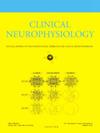Auditory gating and its clinical correlates in adults with chronic tic disorder and neurotypical adults
IF 3.7
3区 医学
Q1 CLINICAL NEUROLOGY
引用次数: 0
Abstract
Background
Over 80% of adults with chronic tic disorder (CTD) experience sensory over-responsivity (SOR), defined as heightened awareness of and/or behavioral reactivity to commonplace environmental stimuli. One potential mechanism underpinning SOR is sensory gating impairment. Sensory gating is the physiologic process whereby redundant stimuli are filtered out in early perceptual stages. In this study, we compared sensory gating between neurotypical and CTD adults and determined if gating indices associated with SOR.
Methods
Neurotypical (n = 31) and CTD adults (n = 26) completed a clinical assessment, including two SOR measures (Sensory Gating Inventory, SGI; Sensory Perception Quotient, SPQ), and an auditory gating paradigm while monitored on EEG.
Results
CTD adults exhibited greater SOR. Neurotypical and CTD adults did not differ in P50, N100, or P200 gating ratios. In regression analyses, N100 gating ratio was significantly associated with SGI score; the magnitude of this association was greater for neurotypical than CTD adults. No other significant associations emerged between gating ratios and SOR measures.
Conclusion
Findings do not support sensory gating impairment as a mechanism underpinning SOR in CTD.
The relationship between N100 gating and SOR warrants further investigation.
Significance
This is the first study to examine auditory gating in individuals with CTD.
慢性抽搐症成人和神经畸形成人的听觉门控及其临床相关性。
背景:超过 80% 的慢性抽搐症(CTD)成人患者会出现感觉过度反应(SOR),即对普通环境刺激的意识和/或行为反应增强。造成 SOR 的一个潜在机制是感觉门控障碍。感觉门控是在早期感知阶段过滤多余刺激的生理过程。在这项研究中,我们比较了神经畸形和 CTD 成年人的感觉门控,并确定门控指数是否与 SOR 相关:神经畸形(n = 31)和 CTD 成人(n = 26)完成了一项临床评估,包括两项 SOR 测量(感觉门控量表,SGI;感觉知觉商数,SPQ)和一项听觉门控范式,同时进行脑电图监测:结果:CTD 成人表现出更大的 SOR。神经畸形成人和 CTD 成人在 P50、N100 或 P200 门控比率上没有差异。在回归分析中,N100 门控比与 SGI 评分显著相关;神经畸形成人的相关程度高于 CTD 成人。门控比率与 SOR 测量之间没有其他重要关联:结论:研究结果不支持将感觉门控障碍作为导致 CTD SOR 的机制。N100门控与SOR之间的关系值得进一步研究:这是首次研究 CTD 患者的听觉门控。
本文章由计算机程序翻译,如有差异,请以英文原文为准。
求助全文
约1分钟内获得全文
求助全文
来源期刊

Clinical Neurophysiology
医学-临床神经学
CiteScore
8.70
自引率
6.40%
发文量
932
审稿时长
59 days
期刊介绍:
As of January 1999, The journal Electroencephalography and Clinical Neurophysiology, and its two sections Electromyography and Motor Control and Evoked Potentials have amalgamated to become this journal - Clinical Neurophysiology.
Clinical Neurophysiology is the official journal of the International Federation of Clinical Neurophysiology, the Brazilian Society of Clinical Neurophysiology, the Czech Society of Clinical Neurophysiology, the Italian Clinical Neurophysiology Society and the International Society of Intraoperative Neurophysiology.The journal is dedicated to fostering research and disseminating information on all aspects of both normal and abnormal functioning of the nervous system. The key aim of the publication is to disseminate scholarly reports on the pathophysiology underlying diseases of the central and peripheral nervous system of human patients. Clinical trials that use neurophysiological measures to document change are encouraged, as are manuscripts reporting data on integrated neuroimaging of central nervous function including, but not limited to, functional MRI, MEG, EEG, PET and other neuroimaging modalities.
 求助内容:
求助内容: 应助结果提醒方式:
应助结果提醒方式:


